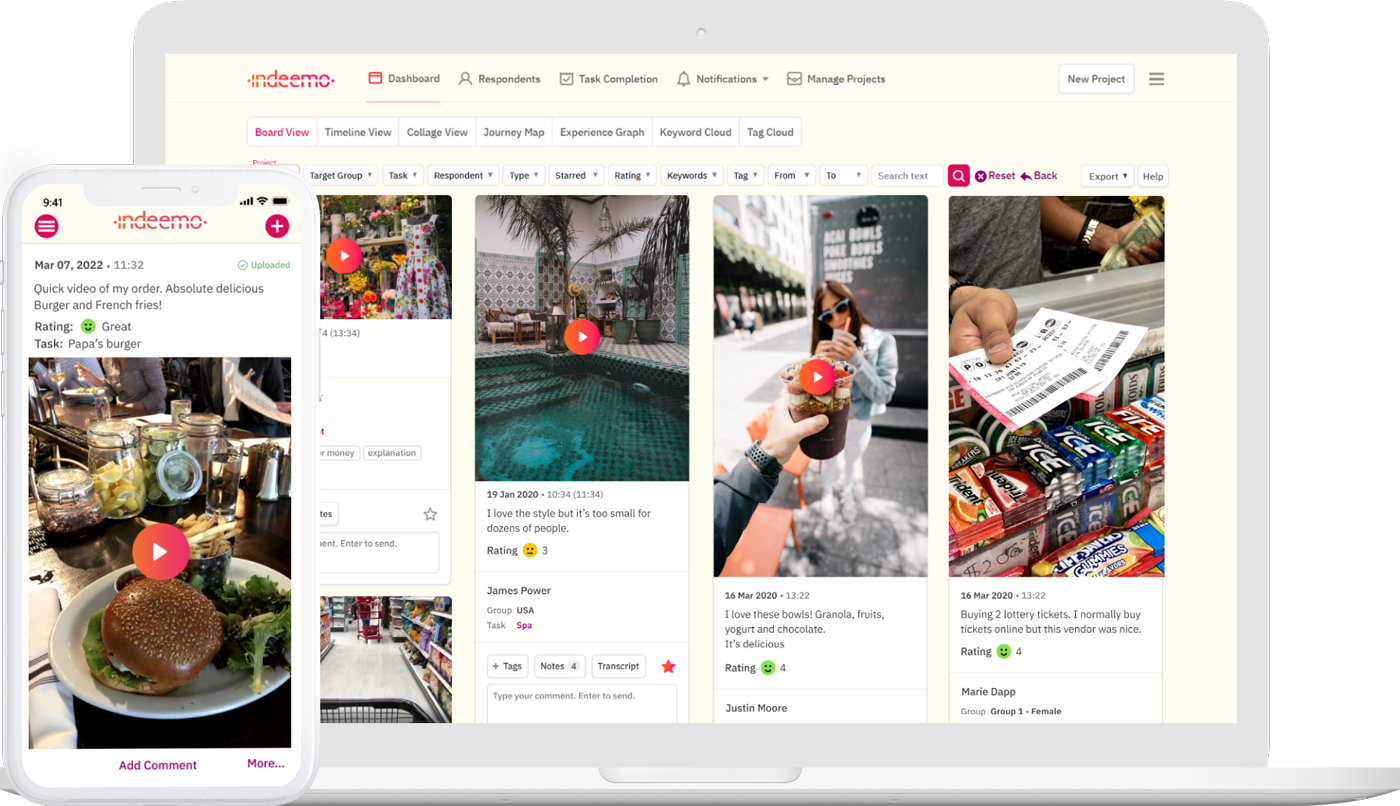However, how we capture, measure, and perceive the voice of the customer is now beginning to pivot. Customer Experience research guides this shift in enhancing our understanding of the real emotions and motivations behind each human interaction with a brand. Increasingly, CX management is informed by insights of a qualitative nature - ensuring empathy building drives change and innovation. In this guide to customer experience research, we provide some key points on the importance of qualitative exploratory research and context to capture true human experiences that will directly inform good customer experience.
What is Customer Experience Research?
Customer experience research is defined by a range of data gathering techniques and strategies that can help uncover actionable insights CX improvement. Whilst traditional approaches to market research and CX insights focused on quantitative insights, organisations are beginning to shift towards searching for deeper meaning and richness to CX insights. Qualitative methods, often underpinned by exploratory research design, are now becoming the foundation for customer experience insights and initiatives. These insights are often used at a seminal stage of CX, and even UX design - customer discovery.
It is at the discovery phase of CX that we aim to gather the true meanings behind the customer. A human-centric approach opens up a world of insights that CX management teams often miss through traditional techniques. The most important element to this is building empathy for customers. Empathy drives good CX. In order to build empathy, CX teams and market research teams require tools and techniques that will help them uncover the meaning, and the why’s behind the quantitative results of traditional methods.
Customer experience research, through the lens of qualitative methods and techniques helps with this. So, how can you design and conduct CX research through this lens?
How do you conduct Customer Experience research?
First, it is important to build a diverse team that will have valuable contributions to your research. Often, CX teams, UX teams, and market research teams work in silos. Although each team might have different goals, there is only one customer. A diverse team with valuable perspectives to bring to the table will help you develop an inclusive research strategy and objective. There should be no doubt that a mix of personas will help uncover more valuable insight into the customer journey. To help you design the best cx research, here are a number of tips to consider.
Define your CX research Objective
Every customer experience research project should have an overall objective. This objective will be formulated through problem statements your team and other stakeholders have identified. Even more, your problem statements should be informed by insights that you have from past CX research projects. These will help you identify gaps in your current standing of the customer experience. As such, this is your secondary research. Gathering and reviewing what it is that you already know and how this can direct your new CX research design.
Experience data gathering techniques
Traditionally, quantitative research methods, like surveys, would be used to build an understanding of customer attitudes towards a product or service. However, CX research teams can often be limited with this type of data. Although quantitative methods might capture what the customer journey touchpoints are, you limit capturing the true nature of your customer's experiences. CX research informed by qualitative data, will help uncover the meaning behind these attitudes.
Recruitment for CX research
Recruiting the right research participants is key to a successful customer experience research strategy. At times, participants can be reluctant to give up their time to engage in qualitative research. If your organisation does not have quick access to potential participants of your customer journey mapping research, market research agencies can always be brought onboard to manage recruitment. Incentives, be it monetary or otherwise, can be useful to motivate strong engagement for your customer journey mapping research.
Further reading
What is Customer Journey Mapping and How to do it?Customer Experience data collection
Tasks will be needed for your customers to record the actions they take, each touchpoint they interact with, and the emotions experienced throughout their journey. Ultimately, you should want to create tasks that will capture the most important details of the customer experience. It is important to be open-ended. Your exploratory approach to CX research should allow participants to be open and comfortable bringing you, the researcher, into their world. Additionally, there is always the risk of participants dropping off. This can be said for any research project. However, we recommend that you run a pilot study - for two primary reasons. First, to ensure that the tools you are using and the design works well,. From a research flow perspective. Second, how much give is there from possible participants.
So, get your team to pilot your new CX research design. Test your methodology and tasks by allowing other members of your organisation to capture and document their experiences with your brand, in real-time. Quickly you will find areas that need improving, and questions or tasks that need to be modified. In addition, a trial and tested run through can give you an idea of what possible personas may emerge through an exploratory approach.
Challenges of Customer Experience Research
CX research is not a mammoth task. In fact, just like taking up anything new, it gets easier and more rewarding with practice. You quickly learn the challenges, and work to reduce the risk of these in future projects.
Sometimes, a qualitative research strategy can be overburdensome - particularly if the research requires too much of your participants over a longer period of time.
Be mindful of the duration of your research and the requirements you set for participants. The rate of responses to any type of research is relative to the burden placed on participants. Of course, a longitudinal design allows for greater scope for contextual insights, but you risk reducing the rate of responses as time goes on.
Always aim to reduce the burden on your participants and make them feel their time is worthwhile. They will engage. This is another reason why it is important to test your research protocol with your team. It is always possible that the more you ask of participants, the less you get back.
Empowering customers to document their experiences as it happens is incredibly valuable. Allow them to bring you into their world. See their environment and their relationships. These rich insights will always be uncovered by implementing qualitative research techniques, such as video diaries, and mobile screen recordings to show each touchpoint across various omnichannels and even buying journeys.
What are the benefits of Customer Experience research?
Building customer empathy
Empathy is always at the centre of good customer experience. Even more, CX research through qualitative methods will always capture richness to customer experience that directly impacts empathy. Empathising with your customers is essential when it comes to innovation and providing the best customer experience.
Develop vivid customer personas
A holistic view of the customer experience can help uncover key issues. Where you can identify pain points across multiple channels, new opportunities are presented that will enable you and your team to innovate and improve the services to provide the best customer experience.
Identify customer pain points
A holistic view of the customer experience can help uncover key issues. Where you can identify pain points across multiple channels, new opportunities are presented that will enable you and your team to innovate and improve the services to provide the best customer experience.
Develop a shared understanding of your Customer Personas
Due to the complexity of the various channels customers can go through, customer experience is not static. In fact, each touchpoint and interaction with your brand will impact how customers feel. CX research can be leveraged to further our understanding of the customer journey. Even more, this can also be leveraged by UX teams, service designers, and market researchers. Each team may focus on one particular point of interaction, or one area of service that appears as a pain point for customers.
Save money
Lastly, it is understood that the information gathered from customer experience research helps to reduce costs significantly in an organisation. How? To simply put, the richness of the insights that are generated are leveraged for effective decision making. Ultimately, customer services and products are adapting and putting the voice of the customer first. By doing so, the product or service is designed with the customer in mind first. As a ripple effect, organisations start to see increased referrals and sales due to word of mouth.
What tools can you use for Customer Experience Research
Customer experience research is constantly evolving. With new insights and new user needs, user researchers look to emerging techniques and methods, and innovative technology for their research projects.
Customer journey mapping tools are now being integrated into research design. Technology that captures the user experience in real time can be streamlined to build visual journey maps.
The use of mobile screen recordings is integral to CX research, which helps us follow and understand the path to purchase.
CASE STUDY
How Indeemo helped a museum to understand the full customer journey and experience of their visitors.
Dairy studies are used to capture the qualitative nature of customer experience. With the use of video diaries, human behaviour is quickly being recognised with emerging insights directly influencing design from the visual component.
Some technological capabilities can streamline user insights into a centralised dashboard for user researchers. It is here that in the moment data gets drawn out to form user insights.
The Indeemo Customer Experience Research tool is designed to bring you closer to your customers by leveraging all these capabilities. For effective customer research, the technological functionalities enable researchers to gather contextual insights from the customers perspective.









